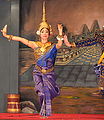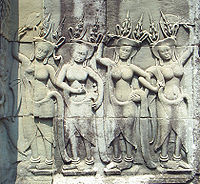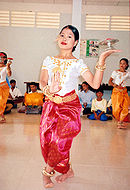
Sampot
Encyclopedia

Dhoti
The dhoti or pancha is the traditional men's garment in the in India, Bangladesh and Sri Lanka. A similar garment is worn in some rural areas of Punjab province in Pakistan, but the use is fast declining...
of Southern Asia. It is also worn in the neighboring countries of Laos
Laos
Laos Lao: ສາທາລະນະລັດ ປະຊາທິປະໄຕ ປະຊາຊົນລາວ Sathalanalat Paxathipatai Paxaxon Lao, officially the Lao People's Democratic Republic, is a landlocked country in Southeast Asia, bordered by Burma and China to the northwest, Vietnam to the east, Cambodia to the south and Thailand to the west...
and Thailand
Thailand
Thailand , officially the Kingdom of Thailand , formerly known as Siam , is a country located at the centre of the Indochina peninsula and Southeast Asia. It is bordered to the north by Burma and Laos, to the east by Laos and Cambodia, to the south by the Gulf of Thailand and Malaysia, and to the...
where they are known as pha nung (ผ้านุ่ง).
Origins

Lungi
The Lungi , also known as a sarong , is a traditional garment worn around the waist in India, Pakistan, Bangladesh, Sri Lanka, Burma, Brunei, Indonesia, Malaysia, Singapore, the Horn of Africa and the southern Arabian Peninsula...
and dhoti
Dhoti
The dhoti or pancha is the traditional men's garment in the in India, Bangladesh and Sri Lanka. A similar garment is worn in some rural areas of Punjab province in Pakistan, but the use is fast declining...
worn in the Indian subcontinent
Indian subcontinent
The Indian subcontinent, also Indian Subcontinent, Indo-Pak Subcontinent or South Asian Subcontinent is a region of the Asian continent on the Indian tectonic plate from the Hindu Kush or Hindu Koh, Himalayas and including the Kuen Lun and Karakoram ranges, forming a land mass which extends...
, the longyi
Longyi
A longyi is a sheet of cloth widely worn in Burma. It is approximately 2 m long and 80 cm wide. The cloth is often sewn into a cylindrical shape. It is worn around the waist, running to the feet. It is held in place by folding fabric over, without a knot. It is also sometimes folded up to...
worn in Burma, and the sarong
Sarong
A sarong or sarung is a large tube or length of fabric, often wrapped around the waist and worn as a kilt by men and as a skirt by women throughout much of South Asia, Southeast Asia, the Arabian Peninsula, the Horn of Africa, and on many Pacific islands. The fabric most often has woven plaid or...
worn in the Malay archipelago
Malay Archipelago
The Malay Archipelago refers to the archipelago between mainland Southeastern Asia and Australia. The name was derived from the anachronistic concept of a Malay race....
. Silk
Silk
Silk is a natural protein fiber, some forms of which can be woven into textiles. The best-known type of silk is obtained from the cocoons of the larvae of the mulberry silkworm Bombyx mori reared in captivity...
weaving has been an important part of Cambodia's cultural past. It has been documented that people from Takéo Province have woven silk since the Funan era and records, bas-relief and Zhou Daguan
Zhou Daguan
Zhou Daguan was a Chinese diplomat under the Temür Khan, Emperor Chengzong of Yuan. He is most well known for his accounts of the customs of Cambodia and the Angkor temple complexes during his visit there. He arrived at Angkor in August 1296, and remained at the court of King Indravarman III...
's report have shown that looms were used to weave sampots since ancient times. Highly complex methods and intricate patterns have been developed to make the cloth, one of which is the hol method. It involves dyeing patterns on silk before weaving. What remains unique to Cambodian weavers is the uneven twill technique; the reason why they adopted such an unusual method remains unclear. However, little is known about the old Khmer vocabulary for these fabrics, and if the sampot today was simply changed over time from the original Angkorian textiles. The ancient bas-reliefs however provide a complete look at what fabrics were like, down to patterns and pleats. Silk woven pieces are used as heirlooms, in weddings and funerals, and as decoration in temples.
Textiles
There are three important silkSilk
Silk is a natural protein fiber, some forms of which can be woven into textiles. The best-known type of silk is obtained from the cocoons of the larvae of the mulberry silkworm Bombyx mori reared in captivity...
textiles in Cambodia
Cambodia
Cambodia , officially known as the Kingdom of Cambodia, is a country located in the southern portion of the Indochina Peninsula in Southeast Asia...
. They include the ikat silks (chong kiet in Khmer), or hol, the twill-patterned silks and the weft ikat textiles. Patterns are made by tying natural and synthetic fibers on the weft threads and then it is dyed. It is repeated for different colors until the patterns firm and cloth is woven. Traditionally, five colors are used. Red, yellow, green, blue and black are the most used. The Sampot Hol is used as a lower garment and as the sampot chang kben. The Pidan Hol is used as a ceremonial hanging used for religious purposes.
Variations
There are many variations of the sampot, each is worn according to class. The typical regular sampot, known also as the sarongSarong
A sarong or sarung is a large tube or length of fabric, often wrapped around the waist and worn as a kilt by men and as a skirt by women throughout much of South Asia, Southeast Asia, the Arabian Peninsula, the Horn of Africa, and on many Pacific islands. The fabric most often has woven plaid or...
is typically worn by men and women of lower class. It measures approximately one and a half meters and both ends are sewn together. It is tied to safely secure it on the waist.

- The Sampot Phamuong (សំពត់ផាមួង ALA-LCALA-LC RomanizationALA-LC is a set of standards for romanization, or the representation of text in other writing systems using the Latin alphabet. The initials stand for American Library Association - Library of Congress....
: saṃbát phā muaṅ) are many different variations of traditional Khmer textiles. They are single colored and twill woven. There are currently 52 colors used in Sampot Phamuong. The Phamuong Chorabap is a luxurious fabric using up to 22 needles to create. Phamuong variation are rabak, chorcung, anlounh, kaneiv and bantok. It usually uses floral and geometric motifs. The most valuedValue (economics)An economic value is the worth of a good or service as determined by the market.The economic value of a good or service has puzzled economists since the beginning of the discipline. First, economists tried to estimate the value of a good to an individual alone, and extend that definition to goods...
silk used to create the Phamuong is Cambodian yellow silkSilkSilk is a natural protein fiber, some forms of which can be woven into textiles. The best-known type of silk is obtained from the cocoons of the larvae of the mulberry silkworm Bombyx mori reared in captivity...
, known for its fine quality in the region. New designs draw inspiration from ancient patterns on old silk.
The Sampot Hol (សំពត់ហូល ALA-LC
ALA-LC Romanization
ALA-LC is a set of standards for romanization, or the representation of text in other writing systems using the Latin alphabet. The initials stand for American Library Association - Library of Congress....
: saṃbát hūl) is a typical traditional textile. There are two kinds of Sampot Hol, one is a wrapping skirt that uses a technique called chong kiet and twill weave. Influence by the Indian patola, it developed patterns and techniques over the centuries to become a genuine Khmer art style. The sampot hol has over 200 patterns combined with three to five colors, yellow, red, brown, blue, and green. There are four variations, sampot hol, sampot hol por, sampot hol kben and sampot hol ktong. Patterns are usually geometric motifs, animals, and flower motifs.
In daily life
The Sampot is deeply rooted in CambodiaCambodia
Cambodia , officially known as the Kingdom of Cambodia, is a country located in the southern portion of the Indochina Peninsula in Southeast Asia...
. Even though the French
France
The French Republic , The French Republic , The French Republic , (commonly known as France , is a unitary semi-presidential republic in Western Europe with several overseas territories and islands located on other continents and in the Indian, Pacific, and Atlantic oceans. Metropolitan France...
brought a degree of westernization
Westernization
Westernization or Westernisation , also occidentalization or occidentalisation , is a process whereby societies come under or adopt Western culture in such matters as industry, technology, law, politics, economics, lifestyle, diet, language, alphabet,...
to Cambodia, Cambodians continued to wear the Sampot. Royalty
Royal family
A royal family is the extended family of a king or queen regnant. The term imperial family appropriately describes the extended family of an emperor or empress, while the terms "ducal family", "grand ducal family" or "princely family" are more appropriate to describe the relatives of a reigning...
and government officials used the sampot chang kben with a formal jacket. The sampot chan kben and sampot pamung are still worn by Cambodians today during special occasions, and rural and poor Khmers still prefer it over western style clothing for its comfort. The material used by poor and rural Cambodians is not hand-woven silk but printed batik-patterned
Batik
Batik is a cloth that traditionally uses a manual wax-resist dyeing technique. Batik or fabrics with the traditional batik patterns are found in Indonesia, Malaysia, Japan, China, Azerbaijan, India, Sri Lanka, Egypt, Nigeria, Senegal, and Singapore.Javanese traditional batik, especially from...
cloth imported from Indonesia
Indonesia
Indonesia , officially the Republic of Indonesia , is a country in Southeast Asia and Oceania. Indonesia is an archipelago comprising approximately 13,000 islands. It has 33 provinces with over 238 million people, and is the world's fourth most populous country. Indonesia is a republic, with an...
. It is still popular with both men and women alike and is regarded by the people of Cambodia as their national garment.
External links
- http://www.camnet.com.kh/cambodia.daily/selected_features/color.htm
- http://www.bookrags.com/research/clothing-traditionalcambodia-ema-02/
See also
- Cambodian clothingCambodian clothingCambodian Clothing also known as the fashion of Cambodia is refer to the style-dress, both from ancient times to present worn by Khmer people.-Textiles:...
- Culture of CambodiaCulture of CambodiaThe culture of Cambodia has had a rich and varied history dating back many centuries, and has been heavily influenced by India. Throughout Cambodia's long history, a major source of inspiration was from religion...
- Culture of ThailandCulture of ThailandThe Culture of Thailand incorporates cultural beliefs and characteristics indigenous to the area known as modern day Thailand coupled with much influence from ancient India, China, Cambodia, along with the neighbouring pre-historic cultures of Southeast Asia...
- LongyiLongyiA longyi is a sheet of cloth widely worn in Burma. It is approximately 2 m long and 80 cm wide. The cloth is often sewn into a cylindrical shape. It is worn around the waist, running to the feet. It is held in place by folding fabric over, without a knot. It is also sometimes folded up to...
- LungiLungiThe Lungi , also known as a sarong , is a traditional garment worn around the waist in India, Pakistan, Bangladesh, Sri Lanka, Burma, Brunei, Indonesia, Malaysia, Singapore, the Horn of Africa and the southern Arabian Peninsula...
- SarongSarongA sarong or sarung is a large tube or length of fabric, often wrapped around the waist and worn as a kilt by men and as a skirt by women throughout much of South Asia, Southeast Asia, the Arabian Peninsula, the Horn of Africa, and on many Pacific islands. The fabric most often has woven plaid or...

